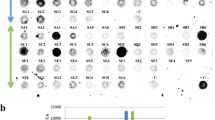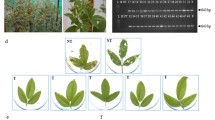Abstract
Transgenic sorghum plants expressing a synthetic cry1Ac gene from Bacillus thuringiensis (Bt) under the control of a wound-inducible promoter from the maize protease inhibitor gene (mpiC1) were produced via particle bombardment of shoot apices. Plants were regenerated from the transformed shoot apices via direct somatic embryogenesis with an intermittent three-step selection strategy using the herbicide Basta. Molecular characterisation based on polymerase chain reaction and Southern blot analysis revealed multiple insertions of the cry1Ac gene in five plants from three independent transformation events. Inheritance and expression of the Bt gene was confirmed in T1 plants. Enzyme-linked immunosorbant assay indicated that Cry1Ac protein accumulated at levels of 1–8 ng per gram of fresh tissue in leaves that were mechanically wounded. Transgenic sorghum plants were evaluated for resistance against the spotted stem borer (Chilo partellus Swinhoe) in insect bioassays, which indicated partial resistance to damage by the neonate larvae of the spotted stem borer. Reduction in leaf damage 5 days after infestation was up to 60%; larval mortality was 40%, with the surviving larvae showing a 36% reduction in weight over those fed on control plants. Despite the low levels of expression of Bt δ-endotoxin under the control of the wound-inducible promoter, the transgenic plants showed partial tolerance against first instar larvae of the spotted stem borer.





Similar content being viewed by others
References
Able JA, Rathus C, Godwin ID (2001) The investigation of optimal bombardment parameters for transient and stable transgene expression in sorghum. In Vitro Cell Dev Biol Plant 37:341–348
Able JA, Rathus C, Carroll BJ, Godwin ID (2004) Enhancing transgene expression levels in sorghum: current status and future goals. In: Seeetharama N, Godwin ID (eds) Sorghum tissue culture and transformation. Oxford, New York, pp 85–96
Alam MF, Datta K, Abrigo E, Vasquez A, Senadhira D, Datta SK (1998) Production of transgenic deep water rice plants expressing a synthetic Bacillus thuringiensis cry1A(b) gene with enhanced resistance to yellow stem borer. Plant Sci 135:25–30
Brietler JC, Cordero MJ, Royer M, Meynard D, San Segundo B, Guiderdoni E (2001) The −689/+197 region of the maize protease inhibitor gene directs high level, wound-inducible expression of the cry1B gene which protects transgenic rice plants from stem borer attack. Mol Breed 7:259–274
Cordero MJ, Raventós D, San Segundo B (1994) Expression of a maize proteinase inhibitor is induced in response to wounding and fungal infection: systemic wound-response of a monocot gene. Plant J 6:141–150
Datta K, Vasquez A, Tu J, Torrizo L, Alam MF, Oliva N, Abrigo E, Khush GS, Datta SK (1998) Constitutive and tissue-specific differential expression of cry1A(b) gene in transgenic rice plants conferring resistance to rice insect pests. Theor Appl Genet 97:20–30
De Maagd RA, Bosch S, Stiekema W (1999) Bacillus thuringiensis toxin-mediated insect resistance in plants. Trends Plant Sci 4:9–13
De Rocher EJ, Vargo-Gogola TC, Diehn SH, Green PJ (1998) Direct evidence for rapid degradation of Bacillus thuringiensis toxin mRNA as a cause of poor expression in plants. Plant Physiol 117:1445–1461
Emani C, Sunilkumar G, Rathore KS (2002) Transgene silencing and reactivation in sorghum. Plant Sci 162:181–192
Finer JJ, Vain P, Jones MW, Mc Mullen MD (1992) Development of the particle inflow gun for DNA delivery to plant cells. Plant Cell Rep 11:323–328
Hagio T, Blowers AD, Earle ED (1991) Stable transformation of sorghum cell cultures after bombardment with DNA-coated microprojectiles. Plant Cell Rep 10:260–264
Harshavardhan D, Rani TS, Ugalanathan K, Seetharama N (2002) An improved protocol for regeneration of Sorghum bicolor from isolated shoot apices. Plant Biotechnol 19:163–171
Hill-Ambroz KL, Weeks JT (2001) Comparision of constitutive promoters for sorghum transformation. Cereal Res Commun 29:17–24
Hill M, Launis K, Bowman C, Mc Pherson K, Dawson J, Watkins J, Koziel M, Wright MS (1995) Biolistic introduction of a synthetic Bt gene into elite maize. Euphytica 85:119–123
Hofte H, Whiteley HR (1989) Insecticidal crystal proteins of Bacillus thuringiensis. Microbiol Rev 53:242–255
Husnain T, Asad J, Maqbool SB, Datta SK, Riazuddin S (2002) Variability in expression of insecticidal Cry1Ab gene in Indica Basmati rice. Euphytica 128:121–128
Jefferson RA (1987) Assaying chimeric genes in plants: the GUS gene fusion system. Plant Mol Biol Rep 5:387–405
Jeoung MJ, Krishnaveni S, Muthukrishnan S, Trick HN, Liang GH (2002) Optimization of sorghum transformation parameters using genes for green fluorescent protein and β-glucuronidase as visual markers. Hereditas 137:20–28
Khanna HK, Raina SK (2002) Elite Indica transgenic rice plants expressing modified Cry1Ac endotoxin of Bacillus thuringiensis show enhanced resistance to yellow stem borer (Scirpophaga incertulas). Transgenic Res 11:411–423
Koziel MG, Beland GL, Bowman C, Carozzi NB, Crenshaw R, Crossland L, Dawson J, Desai N, Hill M, Kadwell S, Launis K, Lewis K, Maddox D, McPherson K, Meghji MR, Merlin E, Rhodes R, Warren GW, Wright M, Evola S (1993) Field performance of elite transgenic maize plants expressing an insecticidal protein derived from Bacillus thuringiensis. Biotechnology 11:194–200
Krishnaveni S, Jeoung JM, Muthukrishnan S, Liang GH (2000) Transgenic sorghum plants constitutively expressing a rice chitinase gene show improved resistance to stalk rot. J Genet Breed 55:151–158
Morikawa H, Sakamoto A, Hokazono H, Irifune K, Takahashmi M (2002) Mechanism of transgene integration into a host genome by particle bombardment. Plant Biotechnol 19:219–228
Murashige T, Skoog F (1962) A revised medium for rapid growth and bioassay with tobacco tissue cultures. Plant Physiol 15:473–497
Nayak P, Basu D, Das S, Basu A, Ghosh D, Ramakrishnan NA, Ghosh M, Sen SK (1997) Transgenic elite Indica rice plants expressing Cry1Ac δ-endotoxin of Bacillus thuringiensis are resistant against yellow stem borer (Scirpophaga incertulas). Proc Natl Acad Sci USA 94:2111–2116
Peferoen M (1997) Progress and prospects for field use of Bt genes in crops. Trends Biotechnol 15:173–177
Ranjekar PK, Patankar A, Gupta V, Bhatnagar R, Bentur J, Kumar PA (2003) Genetic engineering of crop plants for insect resistance. Curr Sci 84:321–329
Sambrook J, Fritsch EF, Maniatis T (1989) Molecular cloning, a laboratory manual, 2nd edn. Cold Spring Harbor Laboratory Press, Cold Spring Harbor, N.Y.
Sardana R, Dukiandjiev S, Giband M, Cheng XY, Cowan K, Sauder C, Altosaar I (1996) Construction and rapid testing of synthetic and modified toxin gene sequences CryIA (b&c) by expression in maize endosperme culture. Plant Cell Rep 15:677–681
Seetharama N, Mythili PK, Rani TS, Harshavardhan D, Ranjani A, Sharma HC (2003) Tissue culture and alien gene transfer in sorghum. In: Jaiwal PK, Singh R (eds) Plant genetic engineering: improvement of food crops, vol 2. Sci Tech Publishing, New Dehlli, India, pp 235–265
Sharma HC (1993) Host plant resistance to insects in sorghum and its role in integrated pest management. Crop Prot 12:11–34
Tadesse Y, Sagi L, Swennen R, Jacobs M (2003) Optimization of transformation conditions and production of transgenic sorghum (Sorghum bicolor) via microparticle bombardment. Plant Cell Tissue Organ Cult 75:1–18
Tamayo MC, Rufat M, Bravo JM, San Segundo B (2000) Accumulation of a maize protease inhibitor in response to wounding and insect feeding, and characterization of its activity toward digestive proteinases of Spodoptera littoralis larvae. Planta 211:62–71
Zhong H, Wang W, Sticklen M (1998) In vitro morphogenesis of Sorghum bicolor (L.) Moench: efficient plant regeneration from shoot apices. J Plant Physiol 153:719–726
Zhu H, Muthukrishnan S, Krishnaveni S, Wilde G, Jeoung JM, Liang GH (1998) Biolistic transformation of sorghum using a rice chitinase gene. J Genet Breed 52:243–252
Acknowledgements
This work was supported by AGROPOLIS Advanced Research platform, France, for which the authors are thankful. V. Girijashankar is grateful to University Grants Commission (UGC), New Delhi, India for providing a research fellowship
Author information
Authors and Affiliations
Corresponding author
Additional information
Communicated by P.P. Kumar
Rights and permissions
About this article
Cite this article
Girijashankar, V., Sharma, H.C., Sharma, K.K. et al. Development of transgenic sorghum for insect resistance against the spotted stem borer (Chilo partellus). Plant Cell Rep 24, 513–522 (2005). https://doi.org/10.1007/s00299-005-0947-7
Received:
Revised:
Accepted:
Published:
Issue Date:
DOI: https://doi.org/10.1007/s00299-005-0947-7




